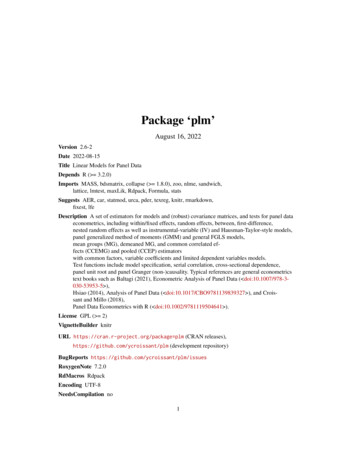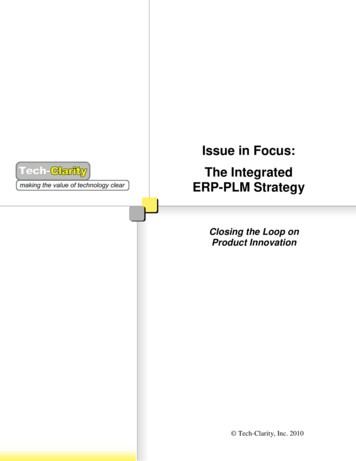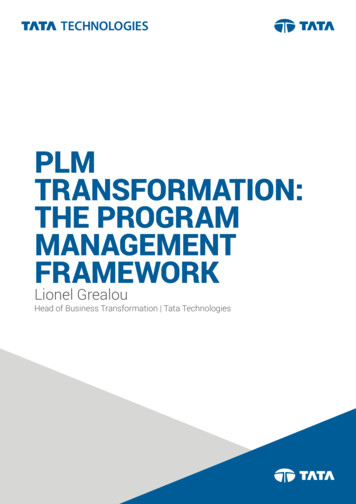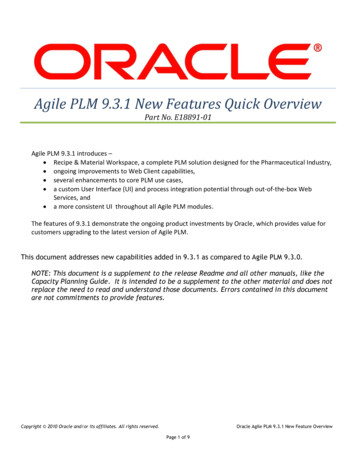
Transcription
Package ‘plm’August 16, 2022Version 2.6-2Date 2022-08-15Title Linear Models for Panel DataDepends R ( 3.2.0)Imports MASS, bdsmatrix, collapse ( 1.8.0), zoo, nlme, sandwich,lattice, lmtest, maxLik, Rdpack, Formula, statsSuggests AER, car, statmod, urca, pder, texreg, knitr, rmarkdown,fixest, lfeDescription A set of estimators for models and (robust) covariance matrices, and tests for panel dataeconometrics, including within/fixed effects, random effects, between, first-difference,nested random effects as well as instrumental-variable (IV) and Hausman-Taylor-style models,panel generalized method of moments (GMM) and general FGLS models,mean groups (MG), demeaned MG, and common correlated effects (CCEMG) and pooled (CCEP) estimatorswith common factors, variable coefficients and limited dependent variables models.Test functions include model specification, serial correlation, cross-sectional dependence,panel unit root and panel Granger (non-)causality. Typical references are general econometricstext books such as Baltagi (2021), Econometric Analysis of Panel Data ( doi:10.1007/978-3030-53953-5 ),Hsiao (2014), Analysis of Panel Data ( doi:10.1017/CBO9781139839327 ), and Croissant and Millo (2018),Panel Data Econometrics with R ( doi:10.1002/9781119504641 ).License GPL ( 2)VignetteBuilder knitrURL https://cran.r-project.org/package plm (CRAN releases),https://github.com/ycroissant/plm (development repository)BugReports e 7.2.0RdMacros RdpackEncoding UTF-8NeedsCompilation no1
R topics documented:2Author Yves Croissant [aut],Giovanni Millo [aut],Kevin Tappe [aut, cre],Ott Toomet [ctb],Christian Kleiber [ctb],Achim Zeileis [ctb],Arne Henningsen [ctb],Liviu Andronic [ctb],Nina Schoenfelder [ctb]Maintainer Kevin Tappe kevin.tappe@bwi.uni-stuttgart.de Repository CRANDate/Publication 2022-08-16 13:00:13 UTCR topics documented:plm-package . . . . . . .aneweytest . . . . . . . .Cigar . . . . . . . . . .cipstest . . . . . . . . .cortab . . . . . . . . . .Crime . . . . . . . . . .detect.lindep . . . . . . .EmplUK . . . . . . . . .ercomp . . . . . . . . .fixef.plm . . . . . . . . .Gasoline . . . . . . . . .Grunfeld . . . . . . . . .has.intercept . . . . . . .Hedonic . . . . . . . . .index.plm . . . . . . . .is.pbalanced . . . . . . .is.pconsecutive . . . . .is.pseries . . . . . . . . .LaborSupply . . . . . .lag.plm . . . . . . . . .make.dummies . . . . .make.pbalanced . . . . .make.pconsecutive . . .Males . . . . . . . . . .model.frame.pdata.framemtest . . . . . . . . . . .nobs.plm . . . . . . . . .Parity . . . . . . . . . .pbgtest . . . . . . . . . .pbltest . . . . . . . . . .pbnftest . . . . . . . . .pbsytest . . . . . . . . 051535456
R topics documented:pcce . . . . . . .pcdtest . . . . . .pdata.frame . . .pdim . . . . . . .pdwtest . . . . .pFtest . . . . . .pggls . . . . . . .pgmm . . . . . .pgrangertest . . .phansitest . . . .pht . . . . . . . .phtest . . . . . .piest . . . . . . .pldv . . . . . . .plm . . . . . . .plm-deprecated .plm.fast . . . . .plmtest . . . . . .pmg . . . . . . .pmodel.responsepooltest . . . . .predict.plm . . .Produc . . . . . .pseries . . . . . .pseriesfy . . . . .punbalancednesspurtest . . . . . .pvar . . . . . . .pvcm . . . . . .pwaldtest . . . .pwartest . . . . .pwfdtest . . . . .pwtest . . . . . .r.squared . . . . .ranef.plm . . . .RiceFarms . . . .sargan . . . . . .Snmesp . . . . .SumHes . . . . .summary.plm.listvcovBK . . . . .vcovDC . . . . .vcovG . . . . . .vcovHC.plm . . .vcovNW . . . . .vcovSCC . . . .Wages . . . . . .within intercept 139140142144146148151153156157
4plm-packageIndex160plm-packageplm package: linear models for panel dataDescriptionplm is a package for R which intends to make the estimation of linear panel models straightforward.plm provides functions to estimate a wide variety of models and to make (robust) inference.DetailsFor a gentle and comprehensive introduction to the package, please see the package’s vignette.The main functions to estimate models are: plm: panel data estimators using lm on transformed data, pvcm: variable coefficients models pgmm: generalized method of moments (GMM) estimation for panel data, pggls: estimation of general feasible generalized least squares models, pmg: mean groups (MG), demeaned MG and common correlated effects (CCEMG) estimators, pcce: estimators for common correlated effects mean groups (CCEMG) and pooled (CCEP)for panel data with common factors, pldv: panel estimators for limited dependent variables.Next to the model estimation functions, the package offers several functions for statistical testsrelated to panel data/models.Multiple functions for (robust) variance–covariance matrices are at hand as well.The package also provides data sets to demonstrate functions and to replicate some text book/paperresults. Use data(package "plm") to view a list of available data sets in the package.Examplesdata("Produc", package "plm")zz - plm(log(gsp) log(pcap) log(pc) log(emp) unemp,data Produc, index c("state","year"))summary(zz)# replicates some results from Baltagi (2013), table 3.1data("Grunfeld", package "plm")p - plm(inv value capital,data Grunfeld, model "pooling")wi - plm(inv value capital,data Grunfeld, model "within", effect "twoways")swar - plm(inv value capital,
aneweytest5data Grunfeld, model "random", effect "twoways")amemiya - plm(inv value capital,data Grunfeld, model "random", random.method "amemiya",effect "twoways")walhus - plm(inv value capital,data Grunfeld, model "random", random.method "walhus",effect "twoways")aneweytestAngrist and Newey’s version of Chamberlain test for fixed effectsDescriptionAngrist and Newey’s version of the Chamberlain testUsageaneweytest(formula, data, subset, na.action, index NULL, .)Argumentsformulaa symbolic description for the model to be estimated,dataa data.frame,subsetsee lm(),na.actionsee lm(),indexthe indexes,.further arguments.DetailsAngrist and Newey’s test is based on the results of the artifactual regression of the within residualson the covariates for all the periods.ValueAn object of class "htest".Author(s)Yves CroissantReferencesAngrist JD, Newey WK (1991). “Over-identification tests in earnings functions with fixed effects.”Journal of Business & Economic Statistics, 9(3), 317–323.
6CigarSee Alsopiest() for Chamberlain’s testExamplesdata("RiceFarms", package "plm")aneweytest(log(goutput) log(seed) log(totlabor) log(size), RiceFarms, index "id")CigarCigarette ConsumptionDescriptiona panel of 46 observations from 1963 to 1992FormatA data frame containing :state state abbreviationyear the yearprice price per pack of cigarettespop populationpop16 population above the age of 16cpi consumer price index (1983 100)ndi per capita disposable incomesales cigarette sales in packs per capitapimin minimum price in adjoining states per pack of cigarettesDetailstotal number of observations : 1380observation : regionalcountry : United StatesSourceOnline complements to Baltagi gi/Online complements to Baltagi (2013):https://bcs.wiley.com/he-bcs/Books?action resource&bcsId 4338&itemId 1118672321&resourceId 13452
cipstest7ReferencesBaltagi BH (2001). Econometric Analysis of Panel Data, 3rd edition. John Wiley and Sons ltd.Baltagi BH (2013). Econometric Analysis of Panel Data, 5th edition. John Wiley and Sons ltd.Baltagi B, Levin D (1992). “Cigarette taxation: Raising revenues and reducing consumption.”Structural Change and Economic Dynamics, 3(2), 321-335. y:1992:i:2:p:321-335.Baltagi BH, Griffin JM, Xiong W (2000). “To Pool or Not to Pool: Homogeneous Versus Heterogeneous Estimators Applied to Cigarette Demand.” The Review of Economics and Statistics, 82(1),117-126. doi:10.1162/003465300558551, oss-sectionally Augmented IPS Test for Unit Roots in Panel ModelsDescriptionCross-sectionally augmented Im, Pesaran and Shin (IPS) test for unit roots in panel models.Usagecipstest(x,lags 2,type c("trend", "drift", "none"),model c("cmg", "mg", "dmg"),truncated FALSE,.)Argumentsxan object of class "pseries",lagsinteger, lag order for Dickey-Fuller augmentation,typeone of "trend" (default), "drift", "none",modelone of "cmg" (default), "mg", "dmg",truncatedlogical, specifying whether to calculate the truncated version of the test (default:FALSE),.further arguments passed to critvals.cips (non-exported function).
8cipstestDetailsPesaran’s (Pesaran 2007) cross-sectionally augmented version of the IPS unit root test (Im et al.2003) (H0: pseries has a unit root) is a so-called second-generation panel unit root test: it is infact robust against cross-sectional dependence, provided that the default model "cmg" is calculated.Else one can obtain the standard (model "mg") or cross-sectionally demeaned (model "dmg") versions of the IPS test.Argument type controls how the test is executed: "none": no intercept, no trend (Case I in (Pesaran 2007)), "drift": with intercept, no trend (Case II), "trend" (default): with intercept, with trend (Case III).ValueAn object of class "htest".Author(s)Giovanni MilloReferencesIm KS, Pesaran MH, Shin Y (2003). “Testing for unit roots in heterogenous panels.” Journal ofEconometrics, 115(1), 53-74.Pesaran MH (2007). “A simple panel unit root test in the presence of cross-section dependence.”Journal of Applied Econometrics, 22(2), 265–312.See Alsopurtest(), phansitest()Examplesdata("Produc", package "plm")Produc - pdata.frame(Produc, index c("state", "year"))## check whether the gross state product (gsp) is trend-stationarycipstest(Produc gsp, type "trend")
cortabcortab9Cross–sectional correlation matrixDescriptionComputes the cross–sectional correlation matrixUsagecortab(x, grouping, groupnames NULL, value "statistic", .)Argumentsxan object of class pseriesgroupinggrouping variable,groupnamesa character vector of group names,valueto complete,.further arguments.ValueA matrix with average correlation coefficients within a group (diagonal) and between groups (offdiagonal).Examplesdata("Grunfeld", package "plm")pGrunfeld - pdata.frame(Grunfeld)grp - c(rep(1, 100), rep(2, 50), rep(3, 50)) # make 3 groupscortab(pGrunfeld value, grouping grp, groupnames c("A", "B", "C"))CrimeCrime in North CarolinaDescriptiona panel of 90 observational units (counties) from 1981 to 1987
10CrimeFormatA data frame containing :county county identifieryear year from 1981 to 1987crmrte crimes committed per personprbarr ’probability’ of arrestprbconv ’probability’ of convictionprbpris ’probability’ of prison sentenceavgsen average sentence, dayspolpc police per capitadensity people per square miletaxpc tax revenue per capitaregion factor. One of ’other’, ’west’ or ’central’.smsa factor. (Also called "urban".) Does the individual reside in a SMSA (standard metropolitanstatistical area)?pctmin percentage minority in 1980wcon weekly wage in constructionwtuc weekly wage in transportation, utilities, communicationswtrd weekly wage in wholesale and retail tradewfir weekly wage in finance, insurance and real estatewser weekly wage in service industrywmfg weekly wage in manufacturingwfed weekly wage in federal governmentwsta weekly wage in state governmentwloc weekly wage in local governmentmix offence mix: face-to-face/otherpctymle percentage of young males (between ages 15 to 24)lcrmrte log of crimes committed per personlprbarr log of ’probability’ of arrestlprbconv log of ’probability’ of convictionlprbpris log of ’probability’ of prison sentencelavgsen log of average sentence, dayslpolpc log of police per capitaldensity log of people per square mileltaxpc log of tax revenue per capitalpctmin log of percentage minority in 1980lwcon log of weekly wage in construction
Crime11lwtuc log of weekly wage in transportation, utilities, communicationslwtrd log of weekly wage in wholesale and retail tradelwfir log of weekly wage in finance, insurance and real estatelwser log of weekly wage in service industrylwmfg log of weekly wage in manufacturinglwfed log of weekly wage in federal governmentlwsta log of weekly wage in state governmentlwloc log of weekly wage in local governmentlmix log of offence mix: face-to-face/otherlpctymle log of percentage of young males (between ages 15 to 24)Detailstotal number of observations : 630observation : regionalcountry : United StatesThe variables l* (lcrmrte, lprbarr, .) contain the pre-computed logarithms of the base variables asfound in the original data set. Note that these values slightly differ from what R’s log() functionyields for the base variables. In order to reproduce examples from the literature, the pre-computedlogs need to be used, otherwise the results differ slightly.SourceJournal of Applied Econometrics Data Archive (complements Baltagi baltagi/Online complements to Baltagi gi/Online complements to Baltagi (2013):https://bcs.wiley.com/he-bcs/Books?action resource&bcsId 4338&itemId 1118672321&resourceId 13452See also Journal of Applied Econometrics data archive entry for Baltagi (2006) at .ReferencesCornwell C, Trumbull WN (1994). “Estimating the economic model of crime with panel data.”Review of Economics and Statistics, 76, 360–366.Baltagi BH (2006). “Estmating an economic model of crime using panel data from North Carolina.”Journal of Applied Econometrics, 21(4).Baltagi BH (2001). Econometric Analysis of Panel Data, 3rd edition. John Wiley and Sons ltd.Baltagi BH (2013). Econometric Analysis of Panel Data, 5th edition. John Wiley and Sons ltd.
12detect.lindepdetect.lindepFunctions to detect linear dependenceDescriptionLittle helper functions to aid users to detect linear dependent columns in a two-dimensional datastructure, especially in a (transformed) model matrix - typically useful in interactive mode duringmodel building phase.Usagedetect.lindep(object, .)## S3 method for class 'matrix'detect.lindep(object, suppressPrint FALSE, .)## S3 method for class 'data.frame'detect.lindep(object, suppressPrint FALSE, .)## S3 method for class 'plm'detect.lindep(object, suppressPrint FALSE, .)## S3 method for class 'plm'alias(object, .)## S3 method for class 'pdata.frame'alias(object,model c("pooling", "within", "Between", "between", "mean", "random", "fd"),effect c("individual", "time", "twoways"),.)Argumentsobjectfor detect.lindep: an object which should be checked for linear dependence(of class "matrix", "data.frame", or "plm"); for alias: either an estimatedmodel of class "plm" or a "pdata.frame". Usually, one wants to input a modelmatrix here or check an already estimated plm model,.further arguments.suppressPrintfor detect.lindep only: logical indicating whether a message shall be printed;defaults to printing the message, i. e., to suppressPrint FALSE,model(see plm),effect(see plm),
detect.lindep13DetailsLinear dependence of columns/variables is (usually) readily avoided when building one’s model.However, linear dependence is sometimes not obvious and harder to detect for less experiencedapplied statisticians. The so called "dummy variable trap" is a common and probably the best–known fallacy of this kind (see e. g. Wooldridge (2016), sec. 7-2.). When building linear modelswith lm or plm’s pooling model, linear dependence in one’s model is easily detected, at times posthoc.However, linear dependence might also occur after some transformations of the data, albeit it is notpresent in the untransformed data. The within transformation (also called fixed effect transformation) used in the "within" model can result in such linear dependence and this is harder to come tomind when building a model. See Examples for two examples of linear dependent columns afterthe within transformation: ex. 1) the transformed variables have the opposite sign of one another;ex. 2) the transformed variables are identical.During plm’s model estimation, linear dependent columns and their corresponding coefficients inthe resulting object are silently dropped, while the corresponding model frame and model matrixstill contain the affected columns. The plm object contains an element aliased which indicatesany such aliased coefficients by a named logical.Both functions, detect.lindep and alias, help to detect linear dependence and accomplish almost the same: detect.lindep is a stand alone implementation while alias is a wrapper aroundstats::alias.lm(), extending the alias generic to classes "plm" and "pdata.frame". aliashinges on the availability of the package MASS on the system. Not all arguments of alias.lm aresupported. Output of alias is more informative as it gives the linear combination of dependentcolumns (after data transformations, i. e., after (quasi)-demeaning) while detect.lindep onlygives columns involved in the linear dependence in a simple format (thus being more suited forautomatic post–processing of the information).ValueFor detect.lindep: A named numeric vector containing column numbers of the linear dependentcolumns in the object after data transformation, if any are present. NULL if no linear dependentcolumns are detected.For alias: return value of stats::alias.lm() run on the (quasi-)demeaned model, i. e., theinformation outputted applies to the transformed model matrix, not the original data.Notefunction detect.lindep was called detect lin dep initially but renamed for naming consistencylater.Author(s)Kevin TappeReferencesWooldridge JM (2013). Introductory Econometrics: a modern approach, 5th edition. SouthWestern (Cengage Learning).
14detect.lindepSee Alsostats::alias(), stats::model.matrix() and especially plm’s model.matrix() for (transformed)model matrices, plm’s model.frame().Examples### Example 1 #### prepare the datadata("Cigar" , package "plm")Cigar[ , "fact1"] - c(0,1)Cigar[ , "fact2"] - c(1,0)Cigar.p - pdata.frame(Cigar)# setup a formula and a model frameform - price 0 cpi fact1 fact2mf - model.frame(Cigar.p, form)# no linear dependence in the pooling model's model matrix# (with intercept in the formula, there would be linear depedence)detect.lindep(model.matrix(mf, model "pooling"))# linear dependence present in the FE transformed model matrixmodmat FE - model.matrix(mf, model "within")detect.lindep(modmat FE)mod FE - plm(form, data Cigar.p, model "within")detect.lindep(mod FE)alias(mod FE) # fact1 -1*fact2plm(form, data mf, model "within") aliased # "fact2" indicated as aliased# look at the data: after FE transformation fact1 -1*fact2head(modmat FE)all.equal(modmat FE[ , "fact1"], -1*modmat FE[ , "fact2"])### Example 2 #### Setup the data:# Assume CEOs stay with the firms of the Grunfeld data# for the firm's entire lifetime and assume some fictional# data about CEO tenure and age in year 1935 (first observation# in the data set) to be at 1 to 10 years and 38 to 55 years, respectively.# CEO tenure and CEO age increase by same value ( 1 year per year).data("Grunfeld", package "plm")set.seed(42)# add fictional dataGrunfeld CEOtenure - c(replicate(10, seq(from s -sample(1:10, 1), to s 19, by 1)))Grunfeld CEOage - c(replicate(10, seq(from s -sample(38:65, 1), to s 19, by 1)))# look at the datahead(Grunfeld, 50)form - inv value capital CEOtenure CEOagemf - model.frame(pdata.frame(Grunfeld), form)# no linear dependent columns in original data/pooling modelmodmat pool - model.matrix(mf, model "pooling")
EmplUK15detect.lindep(modmat pool)mod pool - plm(form, data Grunfeld, model "pooling")alias(mod pool)# CEOtenure and CEOage are linear dependent after FE transformation# (demeaning per individual)modmat FE - model.matrix(mf, model "within")detect.lindep(modmat FE)mod FE - plm(form, data Grunfeld, model "within")detect.lindep(mod FE)alias(mod FE)# look at the transformed data: after FE transformation CEOtenure 1*CEOagehead(modmat FE, 50)all.equal(modmat FE[ , "CEOtenure"], modmat FE[ , "CEOage"])EmplUKEmployment and Wages in the United KingdomDescriptionAn unbalanced panel of 140 observations from 1976 to 1984FormatA data frame containing :firm firm indexyear yearsector the sector of activityemp employmentwage wagescapital capitaloutput outputDetailstotal number of observations : 1031observation : firmscountry : United KingdomSourceArellano M, Bond S (1991). “Some Tests of Specification for Panel Data : Monte Carlo Evidenceand an Application to Employment Equations.” Review of Economic Studies, 58, 277–297.
16ercompercompEstimation of the error componentsDescriptionThis function enables the estimation of the variance components of a panel model.Usageercomp(object, .)## S3 method for class 'plm'ercomp(object, .)## S3 method for class 'pdata.frame'ercomp(object,effect c("individual", "time", "twoways", "nested"),method NULL,models NULL,dfcor NULL,index NULL,.)## S3 method for class 'formula'ercomp(object,data,effect c("individual", "time", "twoways", "nested"),method NULL,models NULL,dfcor NULL,index NULL,.)## S3 method for class 'ercomp'print(x, digits max(3, getOption("digits") - 3), .)Argumentsobjecta formula or a plm object,.further arguments.effectthe effects introduced in the model, see plm() for details,methodmethod of estimation for the variance components, see plm() for details,
ercomp17modelsthe models used to estimate the variance components (an alternative to the previous argument),dfcora numeric vector of length 2 indicating which degree of freedom should be used,indexthe indexes,dataa data.frame,xan ercomp object,digitsdigits,ValueAn object of class "ercomp": a list containing sigma2 a named numeric with estimates of the variance components, theta contains the parameter(s) used for the transformation of the variables: For a one-waymodel, a numeric corresponding to the selected effect (individual or time); for a two-waysmodel a list of length 3 with the parameters. In case of a balanced model, the numeric haslength 1 while for an unbalanced model, the numerics’ length equal the number of observations.Author(s)Yves CroissantReferencesAmemiya T (1971). “The Estimation of the Variances in a Variance–Components Model.” International Economic Review, 12, 1–13.Nerlove M (1971). “Further Evidence on the Estimation of Dynamic Economic Relations from aTime–Series of Cross–Sections.” Econometrica, 39, 359–382.Swamy PAVB, Arora SS (1972). “The Exact Finite Sample Properties of the Estimators of Coefficients in the Error Components Regression Models.” Econometrica, 40, 261–275.Wallace TD, Hussain A (1969). “The Use of Error Components Models in Combining Cross SectionWith Time Series Data.” Econometrica, 37(1), 55–72.See Alsoplm() where the estimates of the variance components are used if a random effects model is estimatedExamplesdata("Produc", package "plm")# an example of the formula methodercomp(log(gsp) log(pcap) log(pc) log(emp) unemp, data Produc,method "walhus", effect "time")# same with the plm methodz - plm(log(gsp) log(pcap) log(pc) log(emp) unemp,
18fixef.plmdata Produc, random.method "walhus",effect "time", model "random")ercomp(z)# a two-ways modelercomp(log(gsp) log(pcap) log(pc) log(emp) unemp, data Produc,method "amemiya", effect "twoways")fixef.plmExtract the Fixed EffectsDescriptionFunction to extract the fixed effects from a plm object and associated summary method.Usage## S3 method for class 'plm'fixef(object,effect NULL,type c("level", "dfirst", "dmean"),vcov NULL,.)## S3 method for class 'fixef'print(x,digits max(3, getOption("digits") - 2),width getOption("width"),.)## S3 method for class 'fixef'summary(object, .)## S3 method for class 'summary.fixef'print(x,digits max(3, getOption("digits") - 2),width getOption("width"),.)## S3 method for class 'pggls'fixef(
fixef.plm)19object,effect NULL,type c("level", "dfirst", "dmean"),vcov NULL,.Argumentseffectone of "individual", "time", or "twoways", only relevant in case of two–ways effects models (where it defaults to "individual"),typeone of "level", "dfirst", or "dmean",vcova variance–covariance matrix furnished by the user or a function to calculate one(see Examples),.further arguments.x, objectan object of class "plm", an object of class "fixef" for the print and thesummary method,digitsdigits,widththe maximum length of the lines in the print output,DetailsFunction fixef calculates the fixed effects and returns an object of class c("fixef", "numeric").By setting the type argument, the fixed effects may be returned in levels ("level"), as deviationsfrom the first value of the index ("dfirst"), or as deviations from the overall mean ("dmean"). Ifthe argument vcov was specified, the standard errors (stored as attribute "se" in the return value) arethe respective robust standard errors. For two-way fixed-effect models, argument effect controlswhich of the fixed effects are to be extracted: "individual", "time", or the sum of individualand time effects ("twoways"). NB: See Examples for how the sum of effects can be split in anindividual and a time component. For one-way models, the effects of the model are extracted andthe argument effect is disrespected.The associated summary method returns an extended object of class c("summary.fixef", "matrix")with more information (see sections Value and Examples).References with formulae (except for the two-ways unbalanced case) are, e.g., Greene (2012), Ch.11.4.4, p. 364, formulae (11-25); Wooldridge (2010), Ch. 10.5.3, pp. 308-309, formula (10.58).ValueFor function fixef, an object of class c("fixef", "numeric") is returned: It is a numeric vectorcontaining the fixed effects with attribute se which contains the standard errors. There are two further attributes: attribute type contains the chosen type (the value of argument type as a character);attribute df.residual holds the residual degrees of freedom (integer) from the fixed effects model(plm object) on which fixef was run. For the two-way unbalanced case, only attribute type isadded.For function summary.fixef, an object of class c("summary.fixef", "matrix") is returned: Itis a matrix with four columns in this order: the estimated fixed effects, their standard errors and
20fixef.plmassociated t–values and p–values. For the two-ways unbalanced case, the matrix contains onlythe estimates. The type of the fixed effects and the standard errors in the summary.fixef objectcorrespond to was requested in the fixef function by arguments type and vcov, respectively.Author(s)Yves CroissantReferencesGreene WH (2012). Econometric Analysis, 7th edition. Prentice Hall.Wooldridge JM
4 plm-package Index 160 plm-package plm package: linear models for panel data Description plm is a package for R which intends to make the estimation of linear panel models straightforward.










